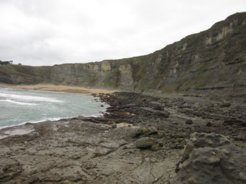A New Approach for Accurately Dating Archaeological Sites Using Marine Mollusc Shells
New study provides marine radiocarbon reservoir effect reference values for the study of chronologies in northern Iberia during the Early- to Mid-Holocene, between 9,000 and 7,500 years ago.
Marine shells are increasingly used to establish the absolute chronologies of archaeological sites and are particularly useful for excavations in which shells represent the majority of the archaeological finds, as is the case for the northern Iberian Peninsula 8,000 years ago. However, radiocarbon dating marine shells can return results that are significantly older than the actual time of deposition, since marine species are typically lower in 14C content than contemporary terrestrial samples that are in equilibrium with the atmosphere. This effect, known as a marine reservoir effect (MRE), can result in radiocarbon dates from marine shells that are several hundred years older than terrestrial organic materials of the same age. Determining the actual marine reservoir effect, therefore, is key for correcting dates obtained from shells.
In a new study published in the journal Quaternary Geochronology, Asier Garcia-Escarzaga, Ricardo Fernandes and Patrick Roberts of the Max Planck Institute for the Science of Human History, in collaboration with scholars from the University of Cantabria (Spain) and University of Kiel (Germany), have explored the marine radiocarbon reservoir effects in northern Iberia during the Early- to Mid-Holocene using a novel Bayesian modelling methodology. The obtained radiocarbon modelling results reveal a temporal variability in MRE that can be interpreted in view of known past climatic and environmental events such as the 8.2k cold event. Moreover, the dataset presented by these researchers also revealed, for the first time for this coastal region, differences in MRE according to mollusc species.
The new, open-access reference set of MRE values for northern Iberia during the Early- to Mid-Holocene can significantly increase the accuracy of chronological determination at archaeological sites and, therefore, has notable implications for understating the human behaviour of the last hunter-gatherers in Atlantic Europe.

